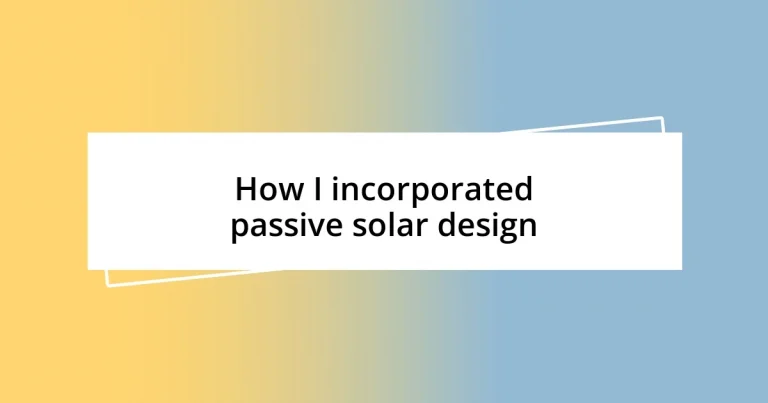Key takeaways:
- Passive solar design optimizes sunlight to enhance comfort and reduce energy reliance through strategic elements like window orientation, thermal mass, and materials.
- Key benefits include cost savings on energy bills, improved indoor air quality, and a decreased carbon footprint, promoting a more sustainable lifestyle.
- Site selection and building orientation play critical roles in maximizing solar efficiency, with thoughtful decisions regarding vegetation and drainage contributing to overall energy effectiveness.
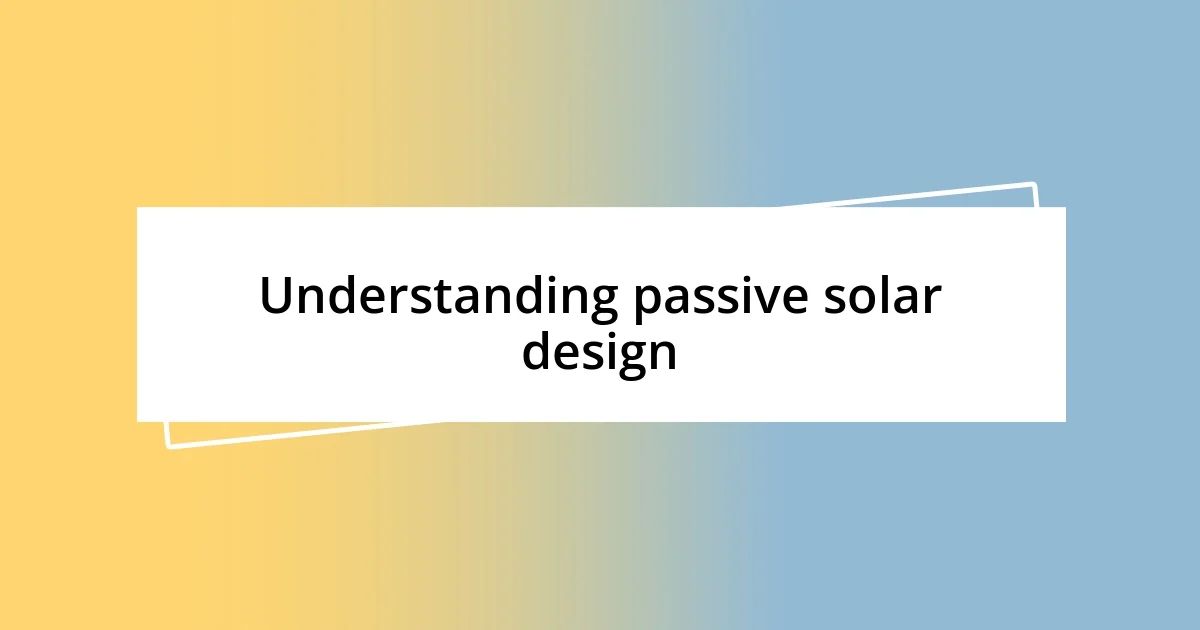
Understanding passive solar design
Passive solar design is often misunderstood, but it fundamentally revolves around harnessing the sun’s energy to create comfortable living spaces. Think about those afternoons when the sun streams in through well-placed windows, warming your home naturally. That’s the essence of passive solar design – optimizing sunlight’s path to reduce dependence on artificial heating and cooling systems.
I still remember the first chilly winter day when my home’s thermal mass really shone. Our living room, with its stone tile floor and large south-facing windows, retained heat long after the sun dipped below the horizon. Have you ever stood in a sunlit room and felt that cozy warmth enveloping you? That’s the magic of thoughtfully designed spaces that take advantage of natural light and airflows.
What truly excites me about passive solar design is its sustainability. It’s not just about comfort; it’s about creating an environmentally friendly haven. Imagine a home that requires minimal energy consumption – how empowering is that? By applying principles like window orientation, overhangs, and insulative materials, I’ve seen firsthand how these strategies can transform a space into a green energy solution.
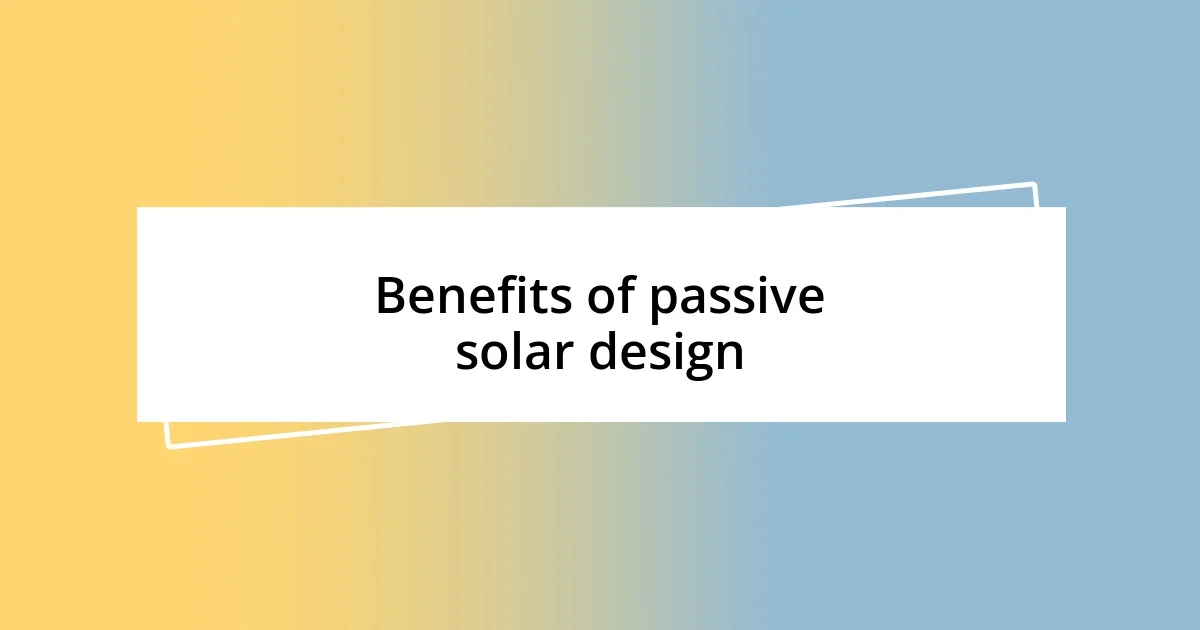
Benefits of passive solar design
The benefits of passive solar design extend far beyond just energy savings. I’ve truly come to appreciate how my home feels in every season. During the blazing summer months, I enjoy cooler indoor temperatures thanks to strategic overhangs that block the harsh sun while still allowing soft, natural light to filter in. It creates a living space that is refreshingly comfortable without relying on air conditioning, which is both a relief for my wallet and a joy for the environment.
Here’s a rundown of some key advantages:
- Cost Savings: Reduced energy bills from natural heating and cooling.
- Comfort: Consistent indoor temperatures, creating a cozy atmosphere.
- Environmental Impact: Decreased reliance on fossil fuels and reduced carbon footprint.
- Durability: Quality materials used in passive design can lead to longer-lasting structures.
- Health Benefits: Improved indoor air quality through better ventilation and natural light exposure.
Reflecting on my experiences, I can say that living in a home designed with passive solar principles enhances my connection to nature. I feel more in tune with the environment, changing my perspective on energy consumption and making me more mindful of my habits. There’s something incredibly satisfying about watching how the sun’s journey across the sky can transform the mood and efficiency of my living space every day.
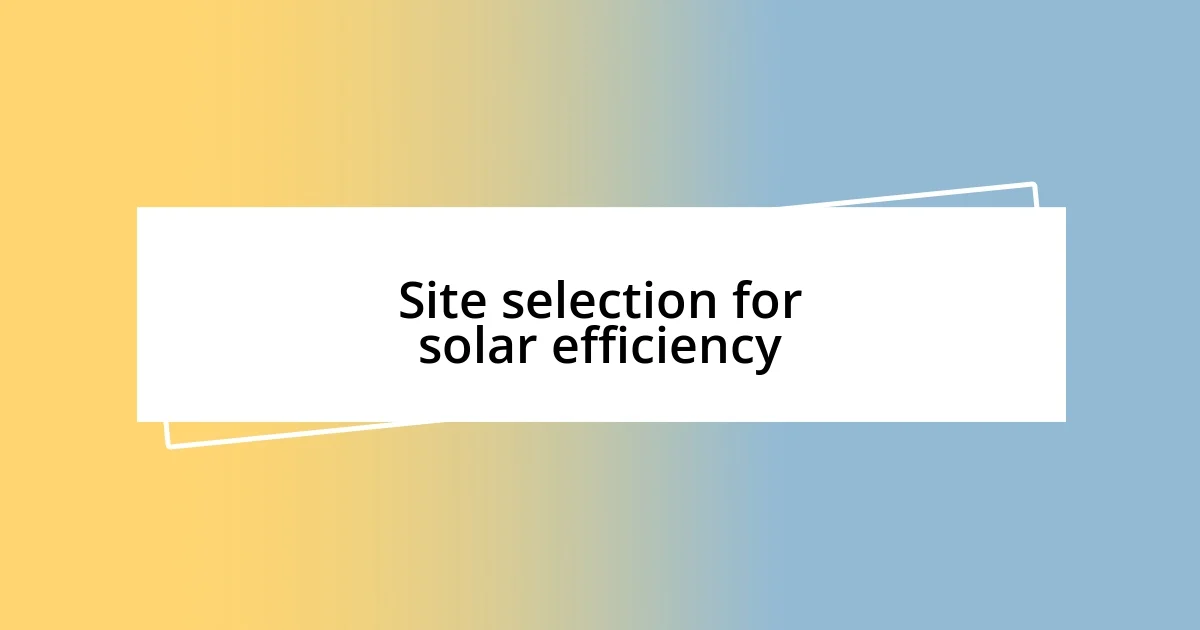
Site selection for solar efficiency
When I was selecting the site for my passive solar home, I understood that location is everything. A well-chosen site can maximize solar access, significantly enhancing energy efficiency. I found myself drawn to a plot that faced south, where the sun’s rays would dance across my living spaces throughout the day. Have you ever experienced how delightful it is to wake up in a sun-soaked room? That’s the feeling I wanted to capture.
In pondering site orientation, I also learned the importance of topography. Building on a gentle slope not only offered gorgeous views but also allocated natural drainage, preventing potential water accumulation around my foundation. I distinctly remember the first time I stood atop that slope during a light rain, watching the water flow away, knowing my home was built wisely. Such decisions might seem minor, but they have long-term impacts on maintenance and energy effectiveness.
Surrounding vegetation also plays a key role in site selection for solar efficiency. Ideally, I wanted to incorporate trees that could provide shade in the summer yet allow sunlight during the winter. I personally took the time to plant deciduous trees strategically, which now create a cooling haven in the heat while shedding their leaves to let in the winter’s warmth. Have you felt the balance nature provides when elements synergize? It’s fascinating to see how thoughtful planning can bring both beauty and efficiency together.
| Site Aspect | Impact on Solar Efficiency |
|---|---|
| Orientation | Maximizes sunlight exposure throughout the year, enhancing natural heating and light. |
| Topography | Influences water drainage and can reduce risks from extreme weather, thus protecting the home’s energy efficiency. |
| Vegetation | Strategic planting offers seasonal shade and light reciprocity, improving indoor climate comfort. |

Building orientation for maximum sunlight
When considering my building’s orientation, I quickly discovered that the south-facing aspect was key to capturing the maximum sunlight throughout the day. I still remember the joy of stepping into the kitchen every morning, where the sun streams in directly, illuminating everything with a warm glow. Isn’t it amazing how that simple morning light can elevate your mood?
I also made sure to account for the surrounding structures when planning the orientation. My neighbor’s tall trees posed a potential shadow threat, so I positioned my house slightly off the optimal angle to dodge their reach. It was a bit tricky, but seeing the sunlight pouring through my living room windows at different times of the year made every moment of consideration worthwhile. Have you ever thought about how slight adjustments in orientation can create such a significant difference in your home’s energy efficiency?
Ultimately, I learned that the orientation of my home not only impacts energy efficiency but also shapes my daily experience. Each season reveals the relationship between my architecture and the sun. During winter, I take particular delight in the soft afternoon sunlight streaming through my study window, creating a perfect spot for cozy reading. In those moments, I truly appreciate how thoughtful design can enhance the simple pleasures of life.
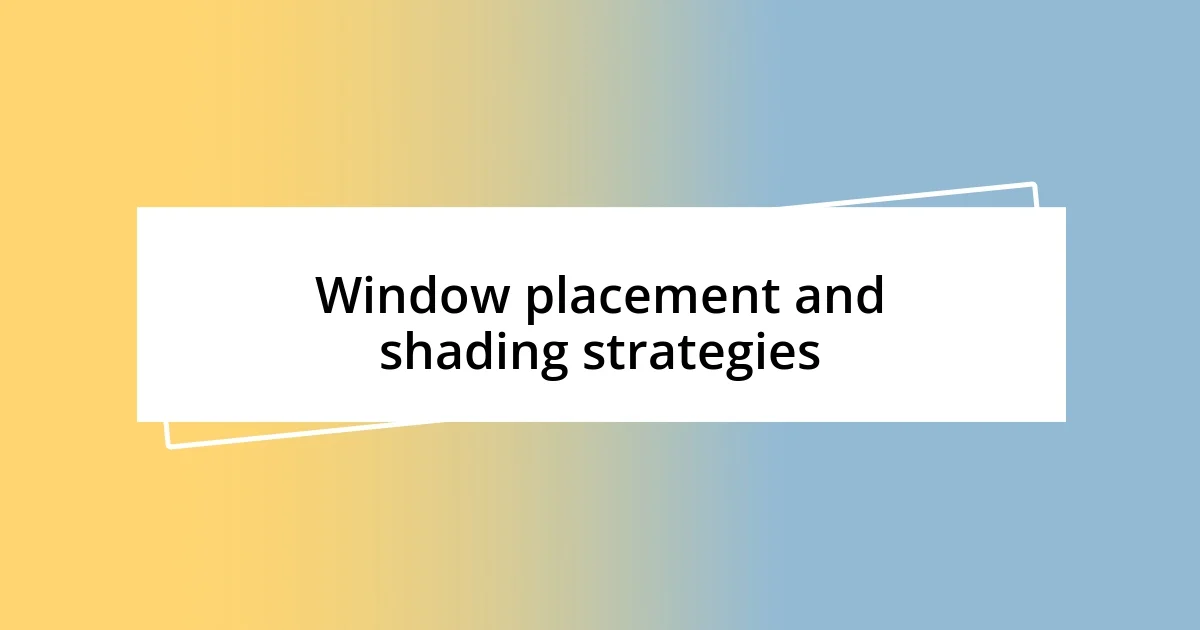
Window placement and shading strategies
Strategically placing my windows has been crucial in harnessing passive solar design. I remember standing in the living room, eyes scanning for the ideal spot for the large south-facing windows. It wasn’t just about aesthetics; it was about creating a space that would flood with natural light in winter, warming the room while minimizing heating costs. Can you imagine how different a space feels when it’s illuminated by sunlight instead of artificial light?
To manage the intense summer heat, I opted for overhangs that shield those sunny windows from blazing rays. I can still picture my first summer, sitting in the shade of those overhangs, sipping iced tea, while the sun blazed brightly overhead. It’s a fascinating balance—using design elements like eaves and awnings to control the sun, providing comfort without losing the benefits of daylight. Don’t you think it’s remarkable how thoughtful design allows us to enjoy nature while maintaining our comfort indoors?
Additionally, I relied on strategically placed smaller windows to enhance cross ventilation. When I first opened those windows on a warm evening, I was greeted with a lovely breeze that danced through the rooms. There’s something truly refreshing about allowing nature to regulate indoor temperatures—it’s like inviting the outside world in. I can’t emphasize enough how these decisions not only improved energy efficiency but also elevated my overall living experience. Wouldn’t you agree that it’s the little things that can transform a house into a home?

Integrating thermal mass in design
Incorporating thermal mass into my design was a revelation that truly transformed my home. I specifically chose materials like concrete and brick, which store heat during the day and release it during cooler nights. I remember one October evening, sitting in my cozy living room, feeling the warmth from the walls envelop me like a soft blanket, even as the temperature outside dropped sharply. Can you believe how much comfort a well-thought-out design can bring?
One of my favorite memories relates to my experience with the thermal mass in my kitchen. After a sunny day, the tiles retained heat beautifully, making morning coffee feel extra special as I savored the warmth underfoot. I found it incredible how this simple detail created a cozy atmosphere, encouraging me to linger a little longer over breakfast. Isn’t it fascinating how the right materials can enhance our daily rituals?
What I didn’t expect was the dramatic difference thermal mass would make on sunny winter days. I recall watching snowflakes dance outside while I remained snug indoors, the sun warming the thick walls. It’s almost like a natural heater, working seamlessly to regulate temperature. Have you ever experienced that wonderful sensation of being warm inside while the world outside is cold? It’s a little slice of magic that makes all the planning worth it.












